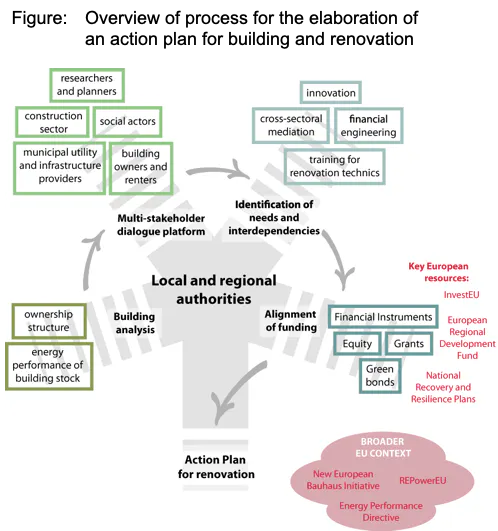EU Green Deal going local & regional: Building and Renovation
October 2022
Saving energy in Europe is more important than ever. As the colder months of the year are approaching, issues linked to heating, energy costs, and the energy efficiency of homes and other buildings occupy a prominent position in policy debates. The energy consumption of building not only significantly increases our fossil fuel dependency. It also accounts for approximately 40% of greenhouse gas emissions. In a context of climate crisis and increasing energy costs due to the Russian military aggression against Ukraine, building renovation may help to decrease Europe’s fossil fuel dependency, to lower emissions, to contain energy poverty, and to strengthen regional resilience. They therefore help reaching the targets of the European Green Deal.
However, strategy design and implementation for renovating buildings is a complex activity. It requires major investments, coordination between a broad range of stakeholders, and is often technically and organisationally challenging. Many regions and municipalities do not have the capacity to fund and implement renovation activities as rapidly as needed to reach Green Deal targets.
The European Union has already in previous programming periods provided extensive financial support to building renovation activities, as well as guidance on how such investments could best be planned, monitored and evaluated. There is also an ongoing revision of European Energy Performance of Buildings Directive. Finally, the European Commission launched the Renovation Wave initiative in 2020. Its objective is to double energy-related renovation rates by 2030.
To help local and regional authorities that are less advanced in their planning and implementation of renovation measures, the Green Deal Going Local Handbook (Opens in a new window) suggests a sequence of steps (see Figure). The objective is to build a process that is evidence-informed, participatory and innovation-driven. This presupposes multi-stakeholder involvement to cover social, economic and environmental demands as well as different fields of expertise, such as technical construction, financial engineering and planning. This shall make it possible to elaborate solutions to reduce energy consumption of buildings that are cost-efficient and ambitious, at the same time as the economic burden is shared in an equitable way.

For each step, the handbook makes some key recommendations.
First, carrying out an analysis of the building stock that may be targeted by renovation activities. This includes an assessment of building characteristics but also of ownership structures. As part of the analytical phase, authorities may also identify local and regional resources that may be mobilised to plan and implement renovation activities.
The successful development of a building and renovation action plan calls for multi-stakeholder involvement and mediation through dialogue platforms. Including building owners, tenants, construction companies, engineering and planning experts makes it possible to specify objectives to be pursued as intermediate targets and broader time horizons.
To elaborate the actual strategy, identifying needs and interdependencies of the different sectors to be mobilised is crucial. These for example include relevant R&D&I milieus, financial engineering experts and organisations providing education and training in the field of renovation techniques. The coordinated timing of activities in these different fields is important.
Regarding the broader EU context, it can be helpful to monitor evolutions of regulatory frameworks. Regulations in the field of building renovation tend to be fast changing, especially in times of crisis. For example, the current European Commission proposals for a revised Energy Performance Directive introduce the notion of ‘Zero-emission buildings’ as a standard for new buildings as of 2030. They also suggest that investments should be targeted on least energy-efficient buildings, by making it compulsory for all buildings to reach certain minimum standards of performance by 2027, 2030 and 2033. The calculation of Life-cycle Global Warming Potentialsfor large new building projects may also change the way in which building performance is assessed. At the same time, some regulatory constraints have been eased to make it possible to accelerate renovation works.
A major challenge for member states and their local and regional authorities is related to financing. A wide range of European funding solutions are available, e.g. InvestEU, European Regional Development Fund programmes and National Recovery and Resilience Plans. Additionally, financial instruments provide alternatives to traditional, non-repayable grants. Such instruments can be particularly relevant for renovation activities, insofar as they generate future energy savings that make investments economically profitable on the medium to long term. Combining and aligning various financing solutions can make renovation activities more financially viable.
Strategy monitoring and follow-up helps to ensure that involved organisations and individuals draw lessons from experiences made and capitalise on them for the design and implementation of future activities. The Handbook suggests the involvement of external technical experts as well as planning authorities in monitoring and follow-up activities. They may also make renovation strategies more resilient in the face of evolving megatrends and external shocks.
All in all, authorities on various levels can take relevant action towards aligning regional and national development with the European Green Deal and achieving its overall objectives. You can read more about the topic in detail in the handbook, which is available here (Opens in a new window).
by Kirsti Hagemann, Erik Gløersen, Arndt Münch and Helene Gorny
https://steadyhq.com/en/spatialforesight/posts/16c0888b-cae4-4847-867d-055060c9abd6 (Opens in a new window) https://steadyhq.com/en/spatialforesight/posts/00b3c0f6-bea6-4f9b-af97-26f0236f51e1 (Opens in a new window) https://steadyhq.com/en/spatialforesight/posts/c73cf180-0c37-4b42-b3a2-ef7e3ad2c5e2 (Opens in a new window)

